







|

|
|
As the presence of invasive aquatic plants is amplified in unique ecological environments, Peace Paper Project responds with creative methods for disposing of these species. We turn to hand papermaking as a productive answer to a blossoming problem that threatens biodiversity in rivers, lakes, and oceans.
Continuing in the footsteps of our peers in the hand papermaking world, we began making paper from invasive aquatic plants in 2014 in San Marcos, Texas.
|
|
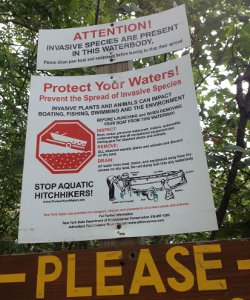
|
|
|
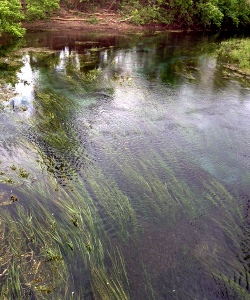
The San Marcos River is home to Texas Wild Rice, which grows only along a seven-mile stretch of this pure and ancient river. The greatest threat to the biodiversity of the pristine San Marcos River is Hydrilla, a non-native plant which can grow up to six inches in one day. The local aquatic research center provided us with eight contractor bags full of Hydrilla that had been meticulously collected from the river.
| |
|
We would have weeded it out ourselves, were it not for the potential for us to propagate the plant further without the knowledge of how to harvest it safely.
After drying out the Hydrilla in the sun, we cut it into tiny pieces and processed it to a pulp form in our Hollander beater. While most natural plant fibers take long to pulp, the structural integrity of Hydilla was such that within five minutes it was blended into a homogeneous green slurry.
|
|
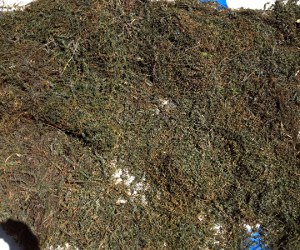
|
|
|
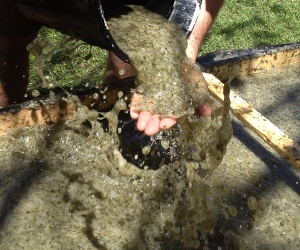
We formed hundreds of sheets of paper with this pulp on our own as well as in public as a way of educating the community as to the threat of invasives to their diverse river.
At the Wild Rice Festival, we set up downstream from our scientist friends and offered passersby the opportunity to form sheets of paper from pulped Hydrilla.
| |
|
In this scenario, our portable studio enabled us to engage a group of people who were present to celebrate the health of the river with the process of making paper by hand from the very species which threatens their river's health.
Against the backdrop of the beautiful San Marcos River, their awareness was attuned to its greatest threat.
|
|
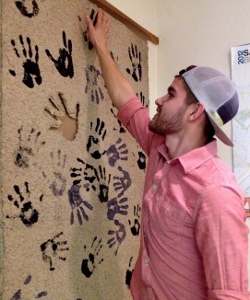
|
|
|
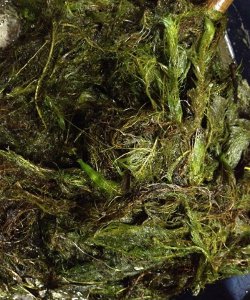
In northern New York, we look to Eurasion Milfoil as another fiber source for papermaking. Like Hydrilla in warmer climates, Eurasion Milfoil is easily spread, and it threatens the beautiful rivers and lakes in the Adirondack Mountains.
Milfoil breaks down in the Hollander beater just as quickly as Hydrilla. It also serves as a powerful teaching tool in educational settings.
| |
|
In the fall of 2014, we collaborated with the Adirondack Watershed Institute of Paul Smith's College to teach students from Saranac Lake High School about the impact of Eurasion Milfoil on lower Saranac Lake.
|
|
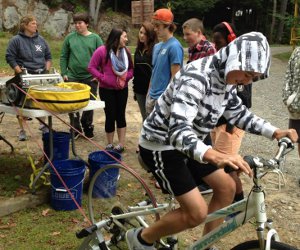
|
|
|
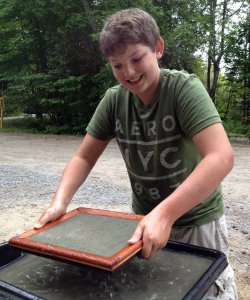
After heading out on the water to observe the vast spread of Milfoil in the lake, students pulped the invasive plant to a dark green slurry by riding the bicycle-operated beater. Pedal-pulping plants like Milfoil and Hydrilla is a breeze, since they break down so quickly.
After making loads of pulp, the students formed sheets of paper along the shore of the lake.
We were all impressed with how quickly the Milfoil became pulp, and how quickly the pulp became stacks of wet papers.
| |
|
As a final engaging touch to complete this messy session, our participants pulp printed images of Milfoil, the Adirondack Park, and proper boat cleaning onto their sheets of paper. The pulp prints served as aesthetically pleasing reminders of the fiber content of the papers.
Coming from an interest in the social aspects of hand papermaking, we pulp invasive plants with the public as a way of showing individuals their potential to have an impact on their environments.
|
|
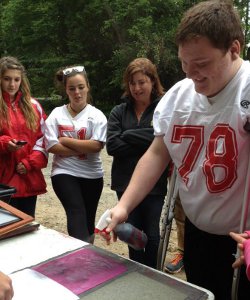
|
|
|
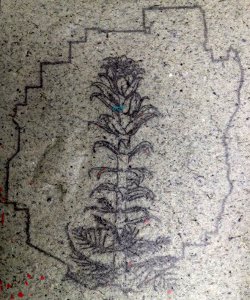
By collaborating with scientists and specialists in environmental conservation, we are able to root our creative process in larger discussions about biodiversity and good practices for maintaining our ecological surroundings.
Our participants are encouraged to set an intention before making their pulp and paper to approach their environment with mindfulness and respect.
| |
|
As they engage in papermaking, they hold this intention, and when they receive their dried papers, they are reminded of their experience and their commitment to their environment.
|
|
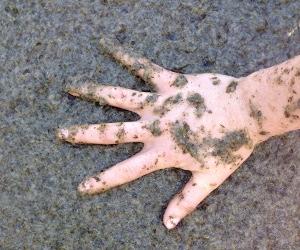
|
|
|
|

